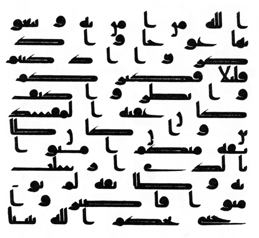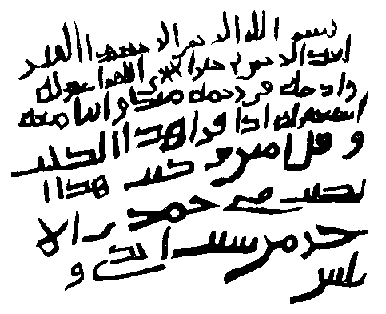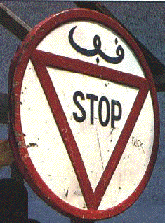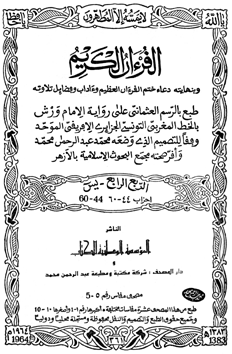![]()
Are There Scribal Errors In The Qur'ân?
Islamic Awareness
© Islamic Awareness, All Rights Reserved.
Assalamu-alaikum wa rahamatullahi wa barakatuhu:
In the following article, we contemplate giving some clues in answer to the strange claims made by Mr. Newton on the scribal issues of the Qur'ân.
In short, the author of that page notices rightfully that the spelling of many words in the Holy Qur'ân does not match their spelling in modern literature. He wishes to prove that the Qur'ân is not miraculous and uses scribal pecularities to support his claims. He, of course, seems to be unaware of the way the Arabic script developed due to many reasons, the primary one being the correct pronunciation of the letters in the Qur'ân.
The Rise & Development Of The Qur'ânic Script
Let us first deal with the idea of introduction of vowel signs in the Qur'ân and the need for then. These signs are called tashkîl in Arabic and they help to determine the correct pronunciation of the word and to avoid mistakes. When the Islamic state expanded, more and more Muslims of non-Arab origin and also many ignorant Arabs studied the Qur'ân, thus faulty pronunciation and wrong readings began to increase. Abû 'Ubaydah narrated about Abû al-Aswad al-Du'alî::
Abû al-Aswad derived grammar from cAlî Ibn Abî Tâlib, for whom may there be peace, but he did not disclose to anyone what he had learned from cAlî, whose countenance may Allah honour, until Ziyad appointed him for the composition of something to serve as a guide to the people, so that they could understand the book of Allah. Abû al-Aswad asked to excused from this task, until one time when he heard a reader recite, Allah is quit of the idolators and of His Apostle (Qur'ân 9:3 should have been read as Allah is quit of the idolators and so is His Apostle). Then he said, "I never supposed that the condition of the people would come to this!" So he returned to Ziyad and said, "I will do what the emir has ordered. Let there be sought for me a scribe who is intelligent and obedient to what I say". They brought, therefore, a scribe from the cAbd al-Kays Tribe, but he [Abû al-Aswad] was not satisfied with him. Then they came with another one, about whom Abû al-cAbbas al-Mubarrad said, "I regard him to be one of those [who are intelligent]." So Abû al-Aswad said [to the new scribe], "If you see that I open my mouth in pronouncing a letter, place a mark above, on top of it. If I close my mouth [making a u sound], place a mark in front of the letter, and if I split [my lips] double the mark." So this was the marking system of Abû al-Aswad.[1]
It is interesting to note that the early manuscripts and parchments of the Qur'ân as well as the inscriptions are devoid of vowel signs.

From the Qur'ân of cUthmân, the Third Rightly Guided Caliph, Kept In Taskent.

Tombstone inscription
of cAbd ar-Rahmân al-Hijri at Aswân,
Egypt.
Dated 31 A. H. / 654 C. E.
(Islamic Museum, Cairo, Egypt)
On the issue of Qur'ânic manuscripts and parchments, Nabia Abbott writes:
When we come to consider the vowel signs, 1st century manuscripts are of no aid, since no such signs appear in any secular document of that date. However, Kur'ân manuscripts credited to the period show a consistent vowel system in which a single red dot above, below, or to the side of a letter stood for the vowels A, I, and U respectively, and two such dots indicated the tanwin. The text of early Kur'âns, however, is never completely voweled, the vowel sign for one or more of the letters of a given word being used only where it was essential for a correct reading. The Arabic traditions place the introduction of the system early in the Muslim era, in fact crediting cAlî with it. Whether cAlî deserves the credit or not makes little difference for the date in question, for the majority of the sources credit a contemporary of cAlî, Abû al-Aswad al-Du'alî, with the system. They tell how, having at first refused to introduce the system at the request of Ziyad Ibn Abihi, governor of Irak, he finally did so when he heard the Kur'ân being wrongly recited. The system could not have been widely spread or generally used, for we find Hajjâj facing the same problem in Irak and ordering Nasr Ibn cAsim to safeguard the pronunciation of the Kur'ân; Nasr, so the story goes, introduced the double dots for the tanwin. even this did not estabish the general use of the system, for again we find Yahya Ibn Yacmar given credit for it, which credit is likewise shared by Hasan al-Basri. Still these efforts and their results proved insufficient, for again Khalîl Ibn Ahmad is credited with introducing the hamzah and the shaddah, the raum and the ishmam, as he is also credited with the vowel signs that are still in use for A, I, and U. The last were originally miniatures of the letters alif, y and w, respectively.[2]
The above quotes clearly mention that the reasons for the introduction of tashkîl and as well as tanwîn signs was, to facilitate the correct reading of the Qur'ân. A superfluous change in the script does not mean it is corrupted.
An excellent example which shows how the Arabic script progressed is the writing of the letter qâf on the Dome of the Rock. The letter qâf is marked by one stroke below it five times on the Dome of the Rock, whereas today, qâf is written with two dots on top. Examples of this kind can only be found in early copies of the Qur'âns. For details of inscriptions on the Dome of the Rock.[3]

(a)

(b)
Comparative study of the Qur'ân scripts adopted in the (a) Middle East and (b) North Africa (except Egypt).
The cursive script of North Africa is called Maghribi script. Notice the dot position for qâf and fa in Maghribi script as well as the verse numbering system! This is from Surah al-Baqarah.
Another important example would be the Maghribi script which is used in North Africa. Before the practice of marking fa with one dot above and qâf with two dots above was established, both these letters were marked by one sign (dot or stroke) only. This usage still persists in Maghribi script, which has fa with a dot below and qâf with a dot above. In early times, however, the opposite way of marking, i.e., fa with a dot above and qâf with a dot below is also attested.
Sometimes, it is also advisable to stop and reflect...

The script of any language (not only Arabic) is subject to many changes and amendments agreed upon by the users of that language throughout history. Writing being a communication tool, the script must be devoid of ambiguity so that the information carried gets from the sender to the recepient without ambiguity. Once in a while, linguists decide to change certain scribal rules in order to simplify the script. For instance, a recent amendment in Arabic script occurred in the middle of the 1980's. It concerned the rules of drawing the hamzah. Originally, in some cases, the hamzah was drawn on a wâw letter and was followed by a long vowel wâw, thus putting two consecutive wâws in the same word. In this regard, Arab linguists decided to eliminate the first wâw and draw the hamzah either on the line or on a hook (nabirah) followed by the second wâw. Here is the illustration of this recent rule:
The following is the spelling of the word/name ra'ûf before the mid-80's:
![]()
![]()
![]()
The following is the spelling of the same word after 1985:

The same applies to many other words like mas'ûliyyah (i.e., responsibility) or sho'ûn (i.e., concerns). So, what do we have here? If the argument of the critic was acceptable then the Arabic literature published before 1985 would be full of errors! Actually, the script being a matter of conventions, one cannot say that books older than 1985 are full of mispelled words while the ones published after that date are correct. In reality, both are correct given the scribal conventions prevailing in their time. It doesn't make sense to judge written material based on conventions other than the ones in which it was written.
It is noteworthy that the Qur'ân is written according to the cUthmânic scribal conventions (rasm) and not according to the modern conventions. After learning the conventions of the cUthmânic script (it is as easy as any alternative convention), any reader is able to read the Holy Qur'ân correctly. This means that the message of the Qur'ân is entirely transmitted from the hardcopy to the reader without ambiguity. It is also noteworthy that the modern script still bears many anomalies that could be amended later. For example, words like dhâlik or lâkin ought to be written with alif letters but, according to the modern scribal conventions, they are written without alif. This is to say that:
![]()
(i.e., lâkin) ought to be written
![]()
and the word
![]()
(i.e., dhâlik) ought to be written
![]()
But even in the modern script those anomalies are not corrected. In the aforementioned elaboration, we have conclusively established that the position of the critic is both unreasonable and ill-founded. One question may remain: Why don't Muslims abandon the cUthmânic script and adopt the modern script? This question needs a separate exposition and may be too lenghty for the purpose of this article. We will discuss about it briefly, insha'allah.
The discussion in this section is adapted from Qur'ânic Orthography: The Written Representation Of The Recited Text Of The Qur'ân by M A S Abdel Haleem, Islamic Quarterly, pp.171-192, 19xx.
In the cUthmânic copies, the Qur'ân was written in a particular rasm (orthography) which became known as al-rasm al-cUthmâni (the cUthmânic way of writing the text of the Qur'ân) also referred to as rasm al-mushaf. As the copies made at his orders and distributed to various parts of the Muslim world were meant to be authoritative, it is no wonder that their rasm assumed authority as the correct way of writing the Qur'ân. Arabic orthography at the time was not yet developed in the way we have known for centuries, particularly in two important areas. There was no distinction between letters of the alphabet of similar shape and there were no vowel marks. This may now give the impression that such a system must have given rise to great confusion in reading. This was not actually the case because the morphological patterns of words in Arabic enable readers to read even very unfamiliar material without the short vowels being marked. More important, however, as far as the Qur'ân was concerned, was the fact that learning and reading relied above all on oral transmission. In the Islamic tradition, writing remained a secondary aid; nevertheless, to ensure correct reading of the written texts of the Qur'ân, particularly for those coming after the first generation of Muslims, steps were taken gradually to improve the orthography. This started with the two above mentioned areas by introducing dots to indicate different vowels and nûnâtion and these were put in different coloured ink from that of the text. There were also dots to distinguish between consonants of similar shape. This work was carried out chiefly by three men: Abû-l-Aswad al-Du'alî (d. 69 / 688), Nasr Ibn cAsim (d. 89 / 707) and Yahyâ Ibn Yacmur (d.129 /746). Understandably there was some opposition at first to adding anything to the way the Qur'ân was written. Ibn cUmar (73/692) disliked the dotting; others welcomed it, clearly because it was, in fact, doing no more than ensuring proper reading of the Qur'ân as received from the Prophet, and this view was accepted by the majority of Muslims throughout the different parts of the Muslims world, from the time of the tâbicûn. The people of Madinah were reported to have used red dots for vowels - tanwîn, tashdîd, takhfîf, sukûn, wasl and madd and yellow dots for the hamzas in particular. Naqt (placing dots on words in the mushaf), became a separate subject of study with many books written on it.
Al-Khalîl Ibn Ahmad (d.170/786) introduced the traditional vowel signs into Arabic orthography instead of the dots, but tht dotting system continued in writing Qur'ânic material. Eventually the traditional vowel signs were adopted for the Qur'ân.
Alongside the development of studies in Arabic grammar,
Arabic orthography also developed for linguistic and literary material, and although
the cUthmânic
rasm was one of the sources of ordinary orthography the latter began to differ
from the cUthmânic
rasm of the Qur'ân. The question was asked whether it was admissible
to write the Qur'ân itself in the new orthography. Mâlik (179/795) was
asked and said: No, the Qur'ân should be written only in the way of the first
writing. He was also asked whether the additional wâw and alif
(as in the word ![]() )
should be deleted since they were not pronounced and said no. Similarly Ibn Hanbal
(244/858) said it was unlawful to deviate in writing the mushâf
in wâw, yâ, alif
or any other way. In line with such views, it
will be seen that adherence to the Qur'ânic rasm has persisted up to
the present.
)
should be deleted since they were not pronounced and said no. Similarly Ibn Hanbal
(244/858) said it was unlawful to deviate in writing the mushâf
in wâw, yâ, alif
or any other way. In line with such views, it
will be seen that adherence to the Qur'ânic rasm has persisted up to
the present.

A fine example of following the rasm al-cUthmâni (The cUthmânic way of writing of the text of the Qur'ân) to this day. The above print is of Warsh Qirâ'ât.
Conclusions
In principle, the cUthmânic script bears more significance than what we may imagine. In fact, not only is it the script in which the first copies of the Holy Qur'ân were written but it bears many references to the Science of Qirâ'ât (Science of Readings) as well. Shifting to the modern script would make the Qirâ'ât aspect a specialist's affair and would deprive "normal" Muslims from even noticing it. The next step would be that the Muslims who are not familiar with Qirâ'ât will become easy prey for anti-Islamic propaganda, the kind of groundless criticism we are rebutting right now. For a short introduction about Qirâ'ât, the readers may insha'allah, refer here.
In short, the claim of so-called scribal errors in the Qur'ân is not only ridiculous but also a fanciful imagination of an extremely ignorant person.
And Allah knows best!
Related Article
Qur'ânic Orthography: The Written Representation Of The Recited Text Of The Qur'ân
Articles Refuting Newton's Works
Pseudo-Callisthenes, Dhul-Qarnain & Alexander The Great
| Islamic Awareness |
References
[1] Bayard Dodge (Editor and Translator), The Fihrist of al-Nadim, 1970, Columbia University Press, pp. 87-88.
[2] Nabia Abbott, The Rise of The North Arabic Script & Its Kur'ânic Development, 1939, The University of Chicago Press, Chicago, p. 39.
[3] Christel Kessler, cAbd al-Mâlik's Inscription In The Dome Of The Rock: A Reconsideration, 1970, The Journal Of The Royal Asiatic Society, pp. 2-14.